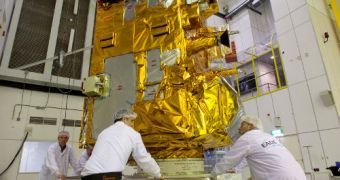Officials at the European Space Agency (ESA) announce that the Payload Module on their latest meteorological satellites has just completed vacuum chamber tests. This is an extremely important mission for the MetOp-B mission, as it demonstrates that the critical component can function at optimum parameters when exposed to the harsh conditions it will meet in our planet's orbit.
The investigations took place at the European Space Research and Technology Center's (ESTEC) Large Space Simulator (LSS), a facility designed specifically for this type of tests. The Payload Module was analyzed thoroughly for more than a month, during which team engineers had sufficient time to assess its functionality and traits. They found everything to be in perfect state, and so they removed the Module from the LSS on July 28.
“Some of MetOp-B’s sensors work under much colder conditions still, because they are actively cooled for optimal performance verification. But those tests had already been done. In these past weeks it was about the Payload Module as a whole and it has proven to be space-proof. As a team, we are very proud about the results obtained,” says of the milestone Luciano Di Napoli, who is the MetOp program manager. He explains that all of the sensitive meteorological instruments that will go on the new satellite are housed in the Payload Module. As such, its integrity is vital to the success of the entire mission.
“By launching a new satellite every five to six years, the MetOp system can provide continuous data for temperature, humidity, cloud cover and gases in the atmosphere, among other things. These data are essential for operational meteorology and climate research,” says MetOp project controller Rob Oremus. Experts at ESTEC say that the LSS is the best facility in the world for simulating the harsh conditions found in space. The chamber, which fits a double-decker bus standing upright, can emulate the vacuum of space, and produce temperature variations of more than 220 degrees Celsius.

 14 DAY TRIAL //
14 DAY TRIAL //